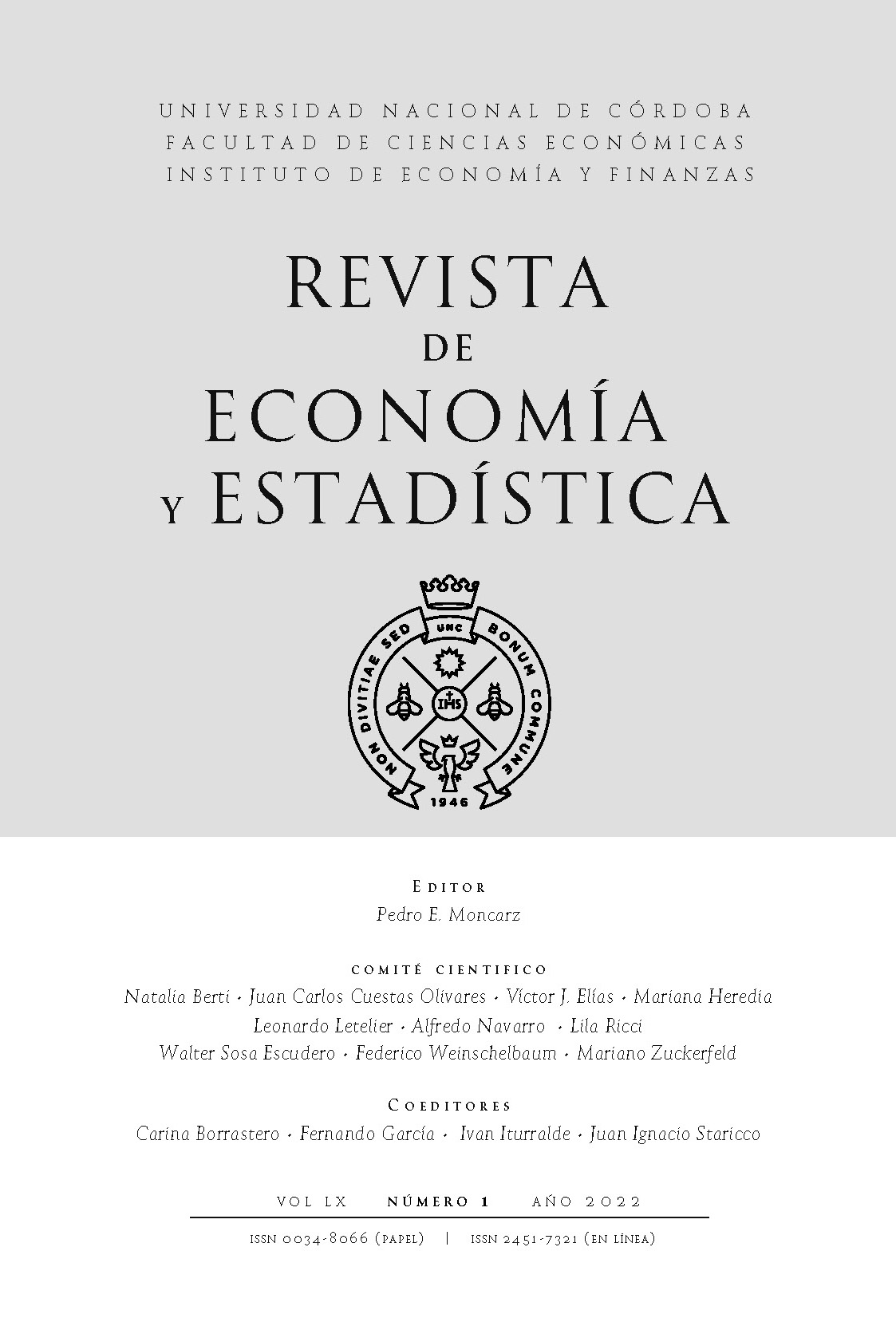Economic growth, formal employment and productive structure
DOI:
https://doi.org/10.55444/2451.7321.2022.v60.n1.37682Keywords:
employment-output elasticity, productive structure, employment-exchange rate elasticity, ARDLAbstract
The relationship between employment and economic growth is of great interest to the economic literature. Although the procyclicality of employment is well known, estimates of elasticities for countries such as Argentina are scarce. Using an autoregressive distributed lagged model (ARDL), this paper estimates the elasticity of formal employment with respect to output and the real exchange rate from administrative records for the period 2007-2019. The results indicate procyclicality is small in the short run but considerable in the long run. Additionally, when dividing employment into productive sectors (following two different levels of disaggregation), we find non-trivial sectoral patterns that point to the importance of the productive structure in the generation of formal employment. The sensitivity to the exchange rate, although small at the aggregate level, adopts relevant values in sectors whose productive insertion makes them typically net exporters or importers. Finally, we provide evidence of different elasticities according to the size of the firms and the sign of the movements in output.
Reception date: 19/05/2022
Acceptance date: 15/07/2022
Downloads
References
Ajakaiye, O., Jerome, A. T., Nabena, D., y Alaba, O. A. (2015). Understanding the relationship between growth and employment in Nigeria. WIDER Working Paper, N° 2015/124. The United Nations University World Institute for Development Economics Research (UNU-WIDER). http://dx.doi.org/10.35188/UNU-WIDER/2015/013-3.
Ajilore, T. y Yinusa, O. (2011). An analysis of employment intensity of sectoral output growth in Botswana. Southern African Business Review, 15(2).
Anderson, B. y Braunstein, E. (2013). Economic growth and employment from 1990-2010: explaining elasticities by gender. Review of Radical Political Economics, 45(3), pp. 269-277.
Autor, D. y Salomons, A. (2018). Is automation labor-displacing? Productivity growth, employment, and the labor share (N° w24871). National Bureau of Economic Research.
Baldwin, R., y Okubo, T. (2019). GVC journeys: Industrialisation and deindustrialisation in the age of the second unbundling. Journal of the Japanese and International Economies, 52, pp. 53-67.
Beccaria, L. A. y Maurizio, R. D. L. (2017). Mercado de trabajo y desigualdad en Argentina. Un balance de las últimas tres décadas. Universidad de Buenos Aires, Facultad de Ciencias Sociales. Revista Sociedad, 37(6), pp. 15-41.
Camargo, J. M. (1999). Apertura económica, productividad y mercado de trabajo. Argentina, Brasil y México. En V. E. Tokmany D. Martínez (eds.), Productividad y empleo en la apertura económica (pp. 11-30). OIT, Perú.
Damill, M., Frenkel, R. y Maurizio, R. (2002). Argentina: una década de convertibilidad. Análisis del crecimiento, el empleo y la distribución del ingreso. OIT, Chile.
Demir, F. (2010). Exchange rate volatility and employment growth in developing countries: Evidence from Turkey. World Development, 38(8), pp. 1127-1140.
Demir, F. y Razmi, A. (2021). The real exchange rate and development theory, evidence, issues and challenges. Journal of Economic Surveys. https://doi.org/10.1111/joes.12418.
Döpke, J. (2001). The "employment intensity" of growth in Europe (N° 1021). Kiel Working Paper. Kiel Institute for the World Economy.
Erten, B. y Metzger, M. (2019). The real exchange rate, structural change, and female labor force participation. World Development, 117, pp. 296-312.
Frenkel, R., & Ros, J. (2006). Unemployment and the real exchange rate in Latin America. World development, 34(4), 631-646.
Furceri, D., Crivelli, E. y Toujas-Bernate, M. J. (2012). Can policies affect employment intensity of growth? A cross-country analysis. International Monetary Fund.
Galindo, A., Izquierdo, A. y Montero, J. M. (2007). Real exchange rates, dollarization and industrial employment in Latin America. Emerging Markets Review, 8(4), pp. 284-298.
Islam, I. y Nazara, S. (2000). Estimating Employment Elasticity for the Indonesian Economy. International Labour Office, Indonesia.
Kapsos, S. (2006). The employment intensity of growth: Trends and macroeconomic determinants. En J. Felipe y R Hasan (eds.), Labor markets in Asia: Issues and perspectives (pp. 143-201). Palgrave Macmillan.
Konopczak, K. (2019). Modelling labour adjustments over the business cycle: evidence from non-linear ARDL model (No. 35). Ministerio de Finanzas, Polonia.
Marx, K. (2008). El capital [28° edición]. Siglo XXI.
Mollick, A. V. (2009). Employment responses of skilled and unskilled workers at Mexican maquiladoras: The effects of external factors. World Development, 37(7), pp. 1285-1296.
Pashtoon, R., Maiwandwal, Z. y Zahid, A. A. (2018). Exports and Employment in Afghanistan: An Econometric Model Using (ARDL) Bounds Test Approach. International Journal of Emerging Technologies and Innovative Research, 5(10), pp. 621-632
Pesaran, M. H., Shin, Y. y Smith, R. J. (2001). Bounds testing approaches to the analysis of level relationships. Journal of applied econometrics, 16(3), pp. 289-326.
Revenga, A. L. y Bentolila, S. (1995). What affects the employment rate intensity of growth?. Banco de España.
Schumpeter, J. (1942). Capitalism, socialism and democracy. Harper.
Seguino, S. y Were, M. (2014). Gender, development and economic growth in Sub-Saharan Africa. Journal of African Economies, 23(suppl_1), i18-i61. DOI:10.1093/jae/ejt024.
Shin, D. (2000). Gender and industry differences in employment cyclicality: Evidence over the postwar period. Economic Inquiry, 38(4), pp. 641-650.
Shin, Y., Yu, B. y Greenwood-Nimmo, M. (2014). Modelling asymmetric cointegration and dynamic multipliers in a nonlinear ARDL framework. En R. C. Sickles y W. C. HorraceIn (eds.), Festschrift in honor of Peter Schmidt (pp. 281-314). Springer.
Stallings, B. y Peres Núñez, W. (2000). Crecimiento, empleo y equidad: el impacto de las reformas económicas en América Latina y el Caribe. CEPAL.
Tokman, V. E. y Martínez, D. (eds.) (1999). Productividad y empleo en la apertura económica. International Labour Organization.
Usman, O. y Elsalih, O. M. (2018). Testing the effects of real exchange rate pass-through to unemployment in Brazil. Economies, 6(3), p. 49. DOI:10.3390/economies6030049.
Published
How to Cite
Issue
Section
License
Copyright (c) 2022 Martin Trombetta, Agustín Duarte Baracat, Azul Menduiña

This work is licensed under a Creative Commons Attribution-NonCommercial-NoDerivatives 4.0 International License.
Authors who have publications with this journal agree to the following terms:
Authors retain their copyright and grant the journal the right of first publication of their work, which is simultaneously subject to the Creative Commons Attribution-NonCommercial-NoDerivatives 4.0 International License that allows third parties to share the work provided that its author and first publication in this journal are indicated.
Authors may adopt other non-exclusive licensing arrangements for distribution of the published version of the work (e.g. depositing it in an institutional telematic archive or publishing it in a monographic volume) as long as the initial publication in this journal is indicated.
Authors are allowed and encouraged to disseminate their work via the Internet (e.g. in institutional telematic archives or on their website) before and during the submission process, which can lead to interesting exchanges and increase citations of the published work. (See The Open Access Effect)









